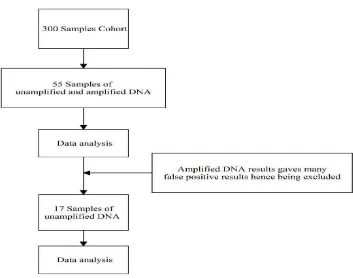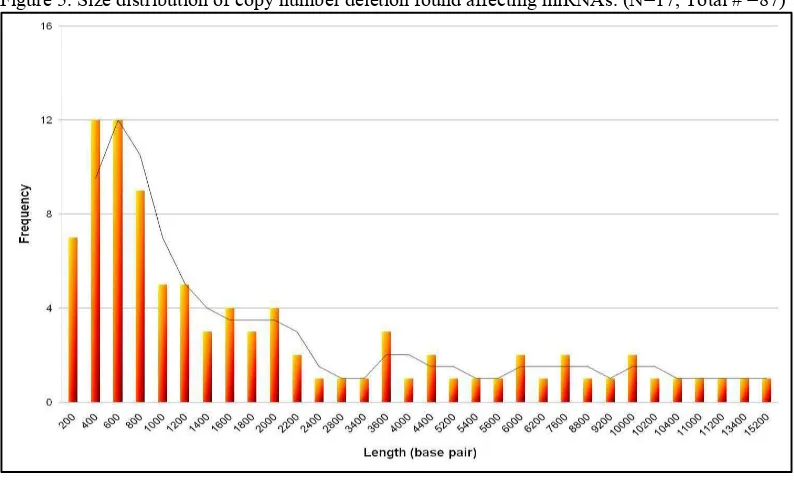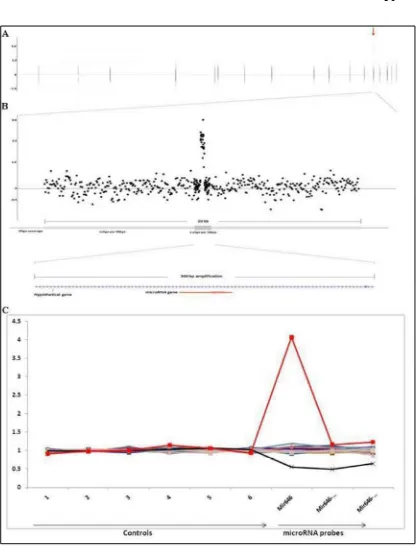CHAPTER V
RESULTS AND DISCUSSION
5.1 MATERIAL SELECTION
Our group has a cohort of 300 young CRC patients with amplified DNA materials. This cohort has been used previously for CNVs analysis using SNP 6.0 and results obtained were robust. Due to the limitation of access to DNA materials, this cohort DNA material was used for our study using custom aCGH.
found to be significantly different (Supplemental 1). Consequently, only unamplified DNA materials results of the array were used from this point on.
Figure 4. Flow chart of material selection. Originally 55 samples out of 300 cohort samples were used for the array using both amplified and unamplified DNA materials. After the data had been analysed, amplified DNA materials gave many false positive results, thus being excluded for the study. After the exclusion, as many as 17 unamplified DNA material samples were used and the data results being used throughout the study.
Figure 5. Size distribution of copy number deletion found affecting miRNAs. (N=17, Total # =87)
Figure 6. Size distribution of copy number duplication found affecting miRNAs. (N=17, Total # = 92)
5.2 GENERAL FINDING
many as 1018 in copy number losses and 745 copy number gains were found using the unamplified DNA materials. The CNVs average of unamplified DNAs showed reduced number of lesions found on the array compared to amplified DNAs. Nonetheless, there were still many noises found on the array. Slight differences were found between the loss and gain size distribution in that most gains had a trend towards a bigger size of lesions compared to losses (figure 6). Next, CNVs found were divided into five groups: unique loss, recurrent loss, kind (gains/losses) where those lesions could be joined into one calling of CNV.
5.3 RECURRENT COPY NUMBER VARIATIONS
We used an in house database of CNVs that had been performed in healthy cohort to check the results of the array. In the small cohort of patients, none of the recurrent CNVs was found on the database.
Table 1. Numbers of CNVs in five major groups. (N=17)
Loss on miRs Recurrences in
As many as 25 unique copy number losses and 18 copy number gains were found and affected 27 and 21 miRs respectively. One unique deletion found on the patient was validated although many were not. The CNV validated affected miR-770 and this CNV was not found in any of the CNV database of healthy cohort. From this information, we gathered that the length of lesions combined with the probe mean value plays a role in determining the calling of real CNVs from false positive.
5.5 CNVs VALIDATION
5.5.1 Duplication
able to be validated using the designed primers. Consequent screening in control showed no duplications were found on the 250 healthy control DNAs (figure 8). The focus of our study this time was on the deletions found on the array due to their less complexity to duplications.
5.5.2 Deletion
5.6 DISCUSSION
In this study copy number analysis affecting miRNAs genes using custom oligonucleotide array (oligo-aCGH) was proven to be a valuable technique to detect small size CNVs. These CNVs found were previously undetected on other array platform. To the best of our knowledge this array is the first to be able to detect small size CNVs targeting miRNA genes compare to other array platforms that has smaller resolution (~10-12 kb). Previous finding of duplication affecting miR-646 led to extensive study of CNVs affecting miRNA in familial CRC. In our study the patient cohort was selected carefully to include 17 patients who have CRC below the age of 40 years old. We found many CNVs affecting miRs that have small size and in addition many of these CNVs were not reported in any of the CNVs database known. Within this small patient cohort several unique CNVs affecting miRNAs in patients but not in controls were validated, namely miR-646 and miR-770. We have shown that these CNVs instead of being polymorphic CNVs may indeed play a role in familial CRC and its predisposition. Nevertheless, regardless of the fact that the array has high resolution, further study needs to be done to optimize the array and the results obtained.
that there is an improper amplification of the DNA samples causing the change on the DNA sequences. On the other hand we observed that unamplified material reduced drastically the false positive results and the background noise detected on the oligo-nucleotide specific array. Though the background noise was reduced, large number of CNVs detected per sample made it difficult to select the microRNAs affected for validation. Furthermore, the threshold settings for the array to distinguish real CNVs amongst the noise were not as straight forward as previously thought. We started validating CNVs of small size (0.05 kb) but were unsuccessful. To follow through, the CNVs affecting miRs with a bigger size (2 any results either. A change towards the validation approach
conclusion that even though qPCR showed a clear deletion, as to why it cannot be validated using PCR is due to the fact that the nature of the deletion on the patient may be more complex than originally expected. Instead of a deletion, this lesion can also represent a reverse translocation. Further study on this occurrence is currently still under way.
Our observation revealed that many CNVs indeed affecting miRNAs. Those CNVs have size ranging between 0.2 15 kb. For both duplication and deletions, most of the CNVs located had the length between 0.2 2 kb. These results confirmed the objective that the array was able to detect small size CNVs affecting miRNAs. These finding also showed that not only big size but also small size CNVs affect miRNA genes. A few years ago, small size CNVs that did not affect any genes were thought to be normal polymorphic CNVs without any possibility of being pathogenic. With the recent finding of miRNA genes many miRNAs have been associated with many diseases including CRC. Thus, small size CNVs might indeed play a role in diseases. We also evaluated the known polymorphic CNV covering miRNA genes using a complied of available CNVs database (internet and results from other groups in the department). We found that 19 miRNAs from the miRNA database are indeed affected by polymorphic CNVs. With this information, we were not able to find these polymorphic miRNA CNVs back in our results. This can be contributed to the small cohort of patients that we performed the array with. Similarly, the unique lesions we found among the small
truly unique lesions. Therefore a bigger cohort of patients is needed to proceed further with the identification of unique or recurrent CNVs affecting miRNAs. Once we identified those CNVs we then have to screen large numbers of healthy controls to ensure the uniqueness of the CNVs.





